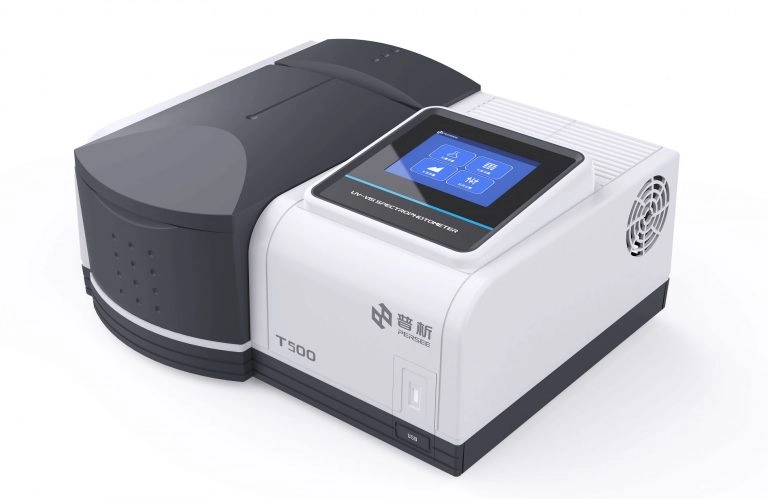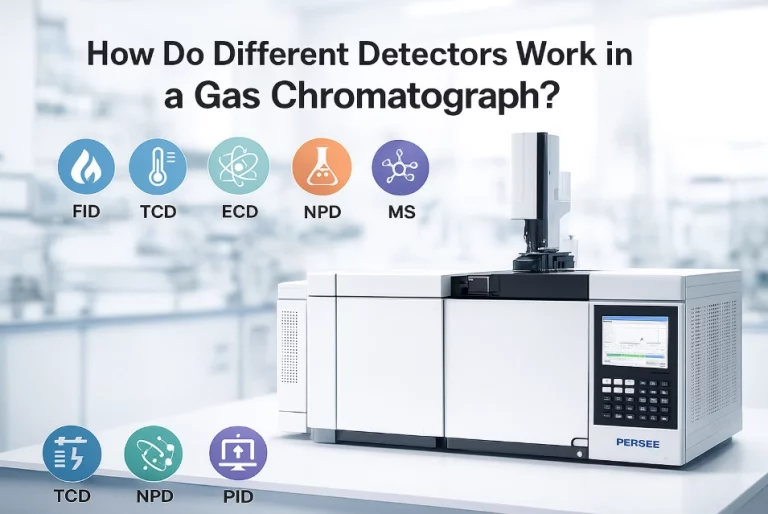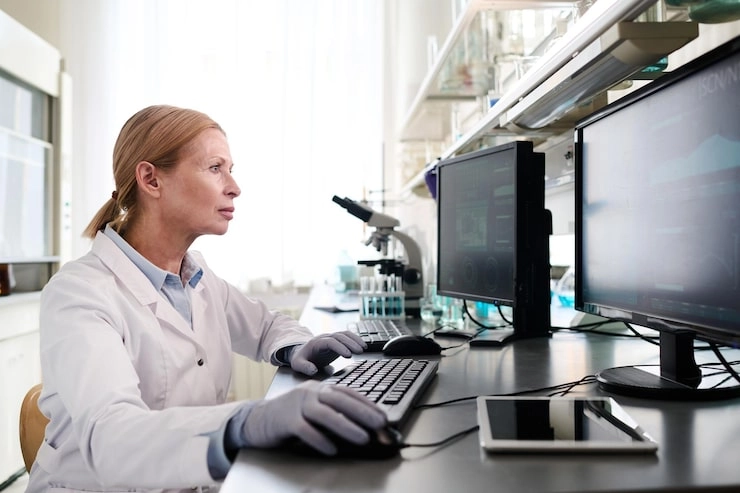
Gas Chromatography Mass Spectrometry (GC-MS) is a strong and useful method that blends the separating power of gas chromatography with the identifying strength of mass spectrometry. This combined tool is widely used in many fields to find and name chemical substances, especially in tricky mixtures or when only tiny amounts are present.
Components and Workflow of GC-MS
GC-MS has two main parts: the gas chromatograph and the mass spectrometer. First, a sample goes into the gas chromatograph. It gets turned into vapor there. Then, the separated pieces move to the mass spectrometer. Here, they get broken into charged bits and detected. These bits create a mass spectrum. This spectrum is compared to big reference collections to figure out what the unknown substances are.
Role of the Gas Chromatograph in Compound Separation
The gas chromatograph uses a thin tube called a capillary column. This tube sits inside an oven. As the sample moves through the column, different substances split apart. They separate because of their boiling points or how they stick to the column’s inner coating.
Function of the Mass Spectrometer in Compound Identification
After splitting, each substance enters the mass spectrometer. It gets ionized, which means it gains a charge. Then, it breaks into smaller pieces. These pieces are sorted by their mass-to-charge ratio (m/z). A detector catches them and makes a unique pattern, like a fingerprint, for each substance.
Sample Introduction and Separation in Gas Chromatography
Getting the sample in correctly and separating it well are key to good GC-MS results.
Volatilization and Injection Techniques
Samples must be able to turn into gas or be made into gas before entering. The injector port heats the sample fast to make it vapor. A tool called a split/splitless injector controls how much sample goes into the column. This helps get clear results.
Column Selection and Retention Time Considerations
Picking the right column matters. It depends on things like the substance’s stickiness, weight, or boiling point. Retention time is how long a substance takes to come out of the column. This time helps guess what the substance might be.
Temperature Control and Carrier Gas Flow Management
The oven’s temperature must be exact to separate substances well. Gases like helium or hydrogen carry the substances through the column. The speed of this gas affects how clear and fast the separation is.
Ionization and Fragmentation in the Mass Spectrometer
Once substances reach the mass spectrometer, they get ionized. This step is vital for detection.
Electron Impact Ionization Process
Electron impact (EI) is a common way to ionize. It hits molecules with fast electrons, usually at 70 eV. This makes molecules lose an electron and become charged ions. It’s a simple and reliable method.
Generation of Fragment Ions from Molecular Structures
The energy from EI often breaks molecules into smaller charged pieces. These pieces form patterns that are unique to each substance. These patterns help figure out what the substance is.
Influence of Ionization on Data Interpretation
Different substances ionize differently, which changes how strong their signals are. Knowing how substances break apart helps understand the patterns in the data correctly.
Mass Analysis and Detection
Mass analyzers sort ions by their m/z ratio before they get detected.
Mass-to-Charge Ratio (m/z) Filtering Mechanisms
Quadrupole Filters
Quadrupole analyzers use electric fields that wiggle to guide ions based on their m/z values. They are small, quick, and great for everyday lab work.
Time-of-Flight Analyzers
Time-of-flight (TOF) analyzers check how fast ions travel through a tube. Lighter ions move faster than heavier ones. This method gives very clear results over a wide range of m/z values.
Signal Detection and Spectrum Generation
Detectors count the ions that arrive at each m/z value. They create a mass spectrum, which is a graph showing how many ions are at each m/z. This graph acts like a unique code for each substance.
Identification of Unknown Compounds Using Mass Spectral Libraries
GC-MS is excellent at finding unknown substances by matching their spectra to big digital collections.
Comparing Sample Spectra with Reference Databases
The mass spectrum is checked against libraries with over 350,000 unique patterns. These libraries have known patterns for many chemicals used in different fields. This comparison helps name the substances.
Criteria for Confident Compound Identification
Match Quality Scores
Software gives a score based on how close the sample’s spectrum is to a library’s spectrum. A high score means the identification is more certain.
Retention Index Matching
Retention indices add another way to confirm what a substance is. They compare the time a substance takes to come out of the column to known times under the same conditions.
Quantitative Analysis with GC-MS
GC-MS doesn’t just identify substances. It also measures how much of a substance is in a sample.
Establishing Calibration Curves with Known Standards
To measure amounts, known substances are tested at different levels. This makes a graph that links signal strength to how much substance is there. This graph is called a calibration curve.
Internal Standards for Enhanced Accuracy
Internal standards are substances not in the sample but act similarly. They are added in known amounts to fix errors from steps like injecting or extracting the sample.
Limits of Detection and Quantification
GC-MS is very sensitive. It can find and measure tiny amounts of substances. This makes it great for tasks like checking for pollution or drugs in small amounts.
Applications Across Industries for Identifying Unknowns
GC-MS is used in many areas because it’s specific and sensitive.
Environmental Monitoring and Contaminant Detection
It finds pollutants like pesticides or gases in air, water, or soil. This helps keep the environment safe and follow rules.
Food Safety Testing for Residues or Adulterants
GC-MS checks food for harmful residues or fake ingredients. It ensures food is safe and high-quality for labs and companies in food, drink, and other fields.
Pharmaceutical Impurity Profiling and Drug Testing
Drug companies use GC-MS to spot unwanted substances during drug-making. It also checks if the main ingredients are correct during quality tests.
Forensic Toxicology and Trace Substance Identification
In forensic work, GC-MS finds drugs, poisons, or explosives in samples like blood or hair, even in tiny amounts. This provides strong evidence for court cases.
Advantages of Combining Chromatography with Mass Spectrometry
Mixing chromatography with mass spectrometry gives many benefits for analysis.
Enhanced Selectivity for Complex Mixtures
Chromatography separates substances in complicated samples before they reach the mass spectrometer. This cuts down on mix-ups and makes results clearer.
Improved Sensitivity for Low-Level Analytes
Mass spectrometry can detect tiny amounts of substances that other tools, like flame ionization detectors, can’t find. This is great for trace analysis.
Structural Elucidation Through Fragmentation Patterns
The patterns from breaking molecules apart give clues about their structure. This helps not only name substances but also understand how they’re built.
Introducing PERSEE: A Reliable Manufacturer in Analytical Instrumentation
PERSEE is a well-known company that makes trusted GC-MS systems and other scientific tools.
Company Background and Industry Certifications
PERSEE, started in 1991, is a modern company focused on making and selling scientific tools. It has earned certifications like ISO9001 and European Union CE, showing its quality and reliability.
Their products include the M7 Single Quadrupole GC-MS, which uses strong quadrupole filtering, and the G5 GC systems, built for precise gas analysis in labs worldwide.


Global Presence and Technical Support Services
The PERSEE brand has a worldwide sales network and a quick support system. It serves thousands of professional customers globally. Their support team gives expert help, ensuring fast assistance no matter where or what the task is.
FAQs
Q1: What makes GC-MS more accurate than other analytical methods?
A: GC-MS is very specific. Unlike tests that might guess a substance and sometimes be wrong, GC-MS clearly identifies substances in a sample. This reduces mistakes when analyzing complex mixtures or checking for tiny amounts of harmful substances.
Q2: Can GC-MS detect very small quantities of substances?
A: Yes. GC-MS is great at finding tiny amounts of substances or contaminants. Its high sensitivity makes it perfect for tasks like forensic work or checking the environment where detecting small amounts is important.
Q3: Is PERSEE’s M7 Single Quadrupole GC-MS suitable for routine lab work?
A: Yes. The M7 model is easy to use and has strong quadrupole filtering. It’s reliable for daily tasks in labs like food safety, drug quality control, or school research centers.










